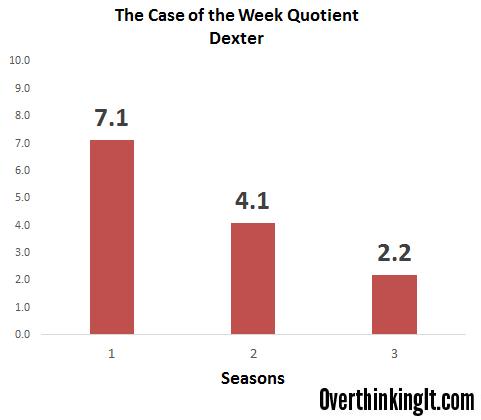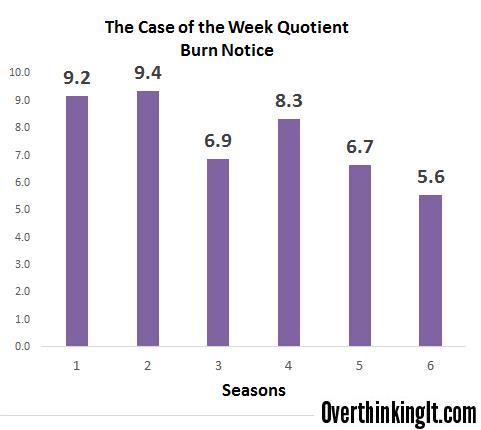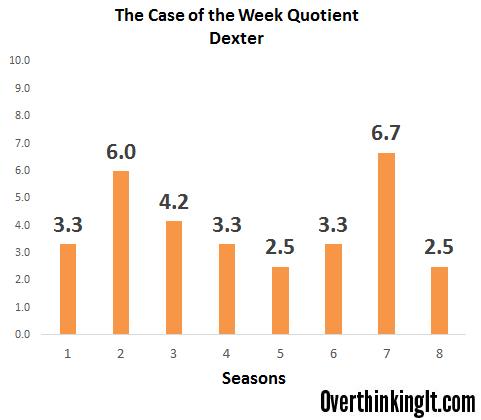Televised storytelling is often characterized as “episodic” storytelling. Whereas a movie generally tells one long story, successful TV in the United States is often about the creation of an engine for continued storytelling. You can’t just tell a story and stop, you have to keep telling stories, until you hit that magic 100 or 200 episodes and the syndication checks start rolling in.
And to a great extent, the “Golden Age of Television” has been about breaking this mold, and telling the kind of stories that match the cinema in unity of purpose and dramatic arc. You will often hear shows like Mad Men characterized as a “serialized” drama, putting it in opposition to the more mundane “episodic” shows of the past.
But of course, a Mad Men or Game of Thrones remains very much the exception to the rule. A huge swath of the TV dial is dominated by shows that are fiercely episodic in their nature. A quick look at a list of TV ratings will show that the vast majority of viewers tune in for a) sports, b) reality shows, c) situation comedies, and d) crime procedurals – none of which are known for their serial story telling prowess. Rather, each of those genres is about a weekly stand-alone story that fits into a season- or series-long arc.
TV is frequently consumed bit by bit, particularly when its packaged up and sold to the USA Network to run three times a day until the heat-death of the universe. Not everyone sees every episode, or watches in the correct order, and so its important that each episode be able to stand on its own, as a story in miniature – you don’t need to know the back story to appreciate a Monday Night Football game, it’s not vital that you have seen every episode of American Idol to appreciate when that girl knocks a Ke$ha song out of the park, and you can walk into another week of CSI: Something Horrible Happens to a Woman without ever having seen any other episodes (or its spinoff, CSI: Something Horrible Happens to a Woman, but This Time It’s in Florida).

YEAHHHHHHHH!
But episodic v. serial isn’t a binary thing. We can imagine putting shows on a spectrum of episodic-ness. At one extreme, you have shows like the original Law and Order, which went out of its way to obscure the lives of the detectives and lawyers that it portrayed. There was little or no season-long storytelling, which is why it is literally impossible to turn on the TV without finding an episode of Law and Order – you can turn it on at any time of the day, and within 5 minutes you’ll be all caught up.
At the other end of the spectrum, there’s a show like Breaking Bad or Game of Thrones, where each episode is a just one link in a long chain of a single story arc. Even though some episodes might stand on their own, it’s very difficult to get into without a solid understanding of who the characters are and where they are in the story.
But in the middle, you have shows with elements of both. In addition to the big season- or series- long story arc, you have the “Case of the Week.” A show like Burn Notice is a good example. In general, each week we meet a new “client” with a problem that will be solved within the next 40 minutes or so, never to be seen or heard from again. But at the same time, we’ll also get a little piece of some bigger puzzle or mythology, inching our way towards the blow-out season finale.
Having identified a spectrum like this, I have to ask – can it be measured? Can we quantify the “Case of the Week”-ness of a season of television? And what does it tell us about a show if this value starts to change?
Towards a Case of the Week Quotient
In order to quantify something like this, I first needed to decide what exactly we’re measuring. Ideally, we could measure the number of minutes per episode that are spent on a “case-of-the-week” vs. the “mythology” of the series. The difficult part about this is just getting the data and adjudicating the margins – if the characters are talking about how the case of the week impacts their investigation of the globe-spanning conspiracy, which category do we put that in? Even if we can answer these kinds of questions, this method would pretty much demand rewatching every episode of the show, cataloging minute by minute.
So instead, I want to focus on the more basic question: what’s the proportion of weeks in which there is actually a Case of the Week? Under this measurement, a pure procedural like Law and Order has a COTW score that’s pretty close to 1.0 – even though there’s a little bit of main character backstory in some episodes, there’s a new “case” every week (barring the occasional crossover or two-parter).

The most difficult part of a L&O reference on Overthinking It – Jack McCoy, or Lenny Briscoe?
It’s probably harder to find a pure 0.0 COTW show – the nature of TV means that there’s almost always at least one or two episodes that have an essentially self-contained story, but it probably looks something like Breaking Bad or House of Cards.
So the method is relatively simple – count the number of episodes with a COTW, and divide by the total number of episodes. (Then multiply by 10 because my lizard brain likes numbers between 1 and 10 more than decimals.) With that out of the way, I’m going to look at a handful of shows using this metric, coding each episode of a show with either a “1” (if that episode has a COTW) or a “0” (if that episode is focused on the larger story arc or mythos).

COTW Case Study #1: Scandal
I’ve previously described Shonda Rhimes’ Scandal as “a soap opera crossed with 24 crossed with a softcore porno crossed with a train wreck.” And I stand by that – it’s truly bonkers. But at the same time, it’s one of the more entertaining dramas on network TV right now.
If you’re not familiar, the main character is Olivia Pope, fantastically portrayed by Kerry Washington. She runs Pope and Associates, nominally a law firm, but really a spin-factory, dedicated to “fixing” the problems of Washington D.C. politicians and associated staffers. Each week, the “white hats” at P&A take on a new client and help them handle the press, win their case, or rescue their daughter from kidnappers (seriously, it’s a bonkers show).
Of course, I’m burying the lede – in addition to her status as a high-powered “fixer”, Olivia Pope is having an affair with the President, her father runs a secret intelligence agency kills people like *all* the time, and her mother is a terrorist. (Again, bonkers).
And my general sense was that as the show has gone on, these plot lines have started to dominate the show, sidelining the “case of the week.” So I took a look at the three seasons of Scandal, coding each episode if there was a “Case of the Week.”
Some of the episodes were border cases – for instance, the fifth episode of Season 3, “More Cattle, Less Bull,” introduces Lisa Kudrow as what appears to be just another “client of the week,” a Senator consulting with Pope and Associates on how to cover up a teenage pregnancy (a pretty tame scandal by Scandal standards). However, at the end of the episode, she offers Olivia a position as her campaign manager for a Presidential run, moving her into the “main” plot involving the President and other related nonsense. She’s written off a few episodes later, so I ended up coding it as a COTW episode. In general, my rule was that a “Case of the week” is defined as an problem that is a) (mostly) handled within the confines of a single episode and b) does not involve a member of the full-time cast of the show.
Here’s what I came up with:

As you can see, my sense of the show is pretty much right – what started out as a largely episodic “Case of the Week” kind of show has gradually morphed into a serial drama, following the shenanigans of B613 and the reelection campaign of Fitzgerald Grant, in which all three (yes, 3) candidates have murdered people during the three seasons of the show’s run (see above, re: bonkers).
OK, so Scandal is an extreme case, going from 70%% COTW to just 25% in the space of two seasons. Let’s look at another show.
COTW Case Study #2: Burn Notice
Like many other people, I suspect, I started out loving Burn Notice and gradually fell away. Largely, it was because of a sense that it had taken a similar path as Scandal – I was always vastly more interested in watching Michael Weston use ridiculous accents to foil gangsters than I was watching a distinguished character actor growl how Michael doesn’t know who he’s dealing with and that this conspiracy goes farther you can possibly imagine. (This is an example of a broader trend of me just not caring about your globe-spanning conspiracy. Many shows can’t resist the allure of some shadowy organization that has people everywhere, and I almost never care. Revenge, I’m looking at you.)
But Burn Notice makes an ideal show to examine for COTW-ness: it literally announces who the “client of the week” is with a subtitle that comes across the screen and says “The Client.”

As a result, the Burn Notice Wiki has a separate field identifying the “client” each week (though the coverage is a little spotty for the last two seasons). Relying on this data where it was available, and the episode descriptions on Wikipedia for the remainder, here’s the results of the Burn Notice COTW analysis:

Though the change is less dramatic, and a less consistent trend, the direction of movement is the same – as the show goes on, the episodic nature starts to fade into the background, and the “mythology” starts to take more center stage.
COTW Case Study #3: Dexter
Dexter is notable for having a readily identifiable “Case of the Season” – each season generally revolves around one or two “big bads.” At the same time, however, Dexter also targets lesser serial killers for his “collection,” often finding, stalking, and killing the target in a single episode. The Dexter Wikipedia contains a DISTURBINGLY thorough catalog of Dexter’s “kills,” and I was able to use that to code the episodes which have a “kill of the week”:

Hrm. Unlike the shows above, there isn’t much of a trend here. The general downward trend from Season 2 to season 5, followed by a spike in Season 6, is probably suggestive of some sort of concious retooling of the show, “getting back to basics as it were.”
And part of the random-ness may be that Dexter was less of a COTW show than I had expected, and so there was less place for it to go. So where Scandal and Burn Notice have COTW built into their DNA, Dexter’s kills were often much more intertwined with the larger plot, and less essential to the week-to-week beats of the show.
There’s one more confounding factor that I realized only after I was done coding the show – there are two kinds of “Cases” on Dexter: his “kills” and Miami Metro’s investigations. They’re harder to pick out, but I suspect the numbers go up if I count one-off investigations by Debra and the gang.
Preliminary Conclusions
Just looking at these three shows, of course, it’s hard to come to any sweeping conclusions. It seems that at the very least, it’s unlikely that a show will increase its Case of the Week Quotient. Less certainly, there appears to be some sort of attractor, pulling shows away from the COTW and towards the mythology-centric storylines
My hypothesis is that this trend has to do with two things. First, our relationship with characters changes over time. At the beginning of a new show, we don’t really know any of the characters, except for by what they do, so it’s important to show us who they are each week. See, Michael is a great guy – he’s always helping out the little guy! As time goes on, however, the audience is invested in the main characters qua main characters, and they don’t need to the prop of helping out a new little guy each week.
Second, the relationship of the show and the network changes over time. For a show like Burn Notice, it’s not hard to imagine how it was pitched to USA: “Michael Weston is a burned spy, using his skills to help people with nowhere else to go, while at the same time finding out who burned him.” That’s the “elevator pitch” before the show gets on air. But as time goes on, the show has a life of its own – it doesn’t need an elevator pitch anymore, and the showrunners are free (if they want) to start exploring the mythology of the series, without being tied to the original logline of the series.

Call for Data
What I’ve found is that coming up with a COTW quotient for a given show is not a trivial task – it takes a fair amount of judgment coding each episode, and it’s time consuming to make that judgment for dozens and dozens of episodes. It also requires familiarity with the show – I chose the three shows above because I watched them regularly enough to be familiar with the characters, and have a general sense of how each episode went.
So now I’ll turn to you, noble Overthinkers, for help – what COTW show do YOU love? Wikipedia is a great source for getting the episode descriptions to jog your memory, and many shows have a seperate wiki out there where people have already done a lot of the work for you.
What I’m generally looking for is a table that looks like this:

You can see all of my data, and find a template for filling in your own, on this Excel sheet. If you went to help out the cause, pull the sheet down, input your data, and send it to [email protected].
My hope is that with some crowd-sourcing, we can get a dataset big enough to get an idea of how the COTW Quotient evolves over time, and what shows are and are not subject to the pull of mythology. So fire up your Netflix/Hulu/Amazon/Magical-TV-box and start watching for the Case of the Week!


Case of the week, serves both practical and narrative purposes, For narrative purposes, it gives an insight into the routine of this unkown people, introducing us to their world, without risking altering the status quo on a weekly basis.
As for practical reasons it allows networks to have viewers come and go as they please in a series, no matter where in its lifespan it may be. It also permits for a formulaic screenwriting, which makes it easier to stage, logistically speaking. In a helper of the week type of series you have almost always the same steps:
1) A pre credits intro where a person is seen in some kind of trouble.
2)Same person goes looking for the team/hero of the series to help them.
3)They make their plan/look for a weakness, lots of exposition dialogue.
4)some sort of complication.
5)final showdown.
6)return to the status quo.
Criminal procedurals follow another path, which all of you may be familiar with, but nevertheless, following this COTW formula allows for an easier production and scheduling, than say something like Game of thrones (which must be a nightmare to edit).
But then there seems to be a couple of issues that pull shows away from this formula: , this is in order to make the characters more intimate to the audience, avoid staleness of the formula with the ocasional game changers, creative dry wells, and as an excuse for casting hiccups.
Now after the above, here is a questions what makes a show succesful in pulling away of the COTW formula? while shows like hannibal and justified have recieved higher critical acclaim when they changed their format, shows like supernatural, burn notice and most noticably the x-files, have fallen out of favor with viewers once the mytharc took over.
Im guessing here, but i think the answer lies in how far away the show was taken from its starting premise by the mytharc, and whether the mytharc elements were a prominent part from the beginning.
In the shows i stated before, in justified the harlan feuds and criminals were there from the beginning, Hannibal had the will/lecter relationship also from the very begining, the series might have changed focus, but they changed focus to what was already there, and albeit the more interesting side of the show.
now supernatural, burn notice and the x-files had angels, spies and aliens come down from the heavens and take away the premise of the show, it isnt that those elements werent there from the start, but they werent as important for the health of the show, and overtook what many people cared about those shows in the first place.
Ben,
Your first chart is incorrectly labeled ‘Dexter’ when clearly you are discussing Scandal
I think certainly our society’s overall COTW quotient is trending downwards; there are very very few older examples of TV series that to have low COTW quotients.
The lowest I can think of is Battlestar Galactica(original series). Compare that to CHiPs, X-files, Knight Rider, etc, etc…
I think this has to do with the advent of ‘Netflix’ and/or ‘On Demand’ TV watching. I think we’re evolving into a society that is more capable of handling a lower COTW quotient.
Great concept!
The one we really need to get up in here is The X-Files, which I understand is arguably the first great example of a show with a firm distinction between “monster-of-the-week” episodes and “mytharc” episodes. I’ve never really watched it extensively, though, so I’m reluctant to dive into the questions. But there’s probably a wiki that’s done that work already.
One that would be a little harder to quantify but I would be interested to see would be Star Trek: Deep Space Nine. I recall even watching it through the first time that I was very interested as it converted from single-episode stories to longer arcs. The problem, of course, is that DS9 doesn’t have a straightforward “case” structure, so I’m not sure how one would code it in.
Angel: The Series is an interesting one that I might actually try to code out for you. It’s interesting because its COTW quotient starts high in the first season, drops in the second season, plummets close to zero over the course of the third and fourth seasons, then skyrockets back up close to 1 in the fifth season–the writers made a conscious effort to get back to episodic storytelling after the epic season 3/4 plot.
I’m working on the x-files, which has a data rich wiki page (with monster-of-the-week episodes clearly labeled as such, which is nice.) Angel, as well as Buffy, would be great shows to look at.
A pan-sci-fi comparison, including X-files, Buffy, Angel, Supernatural, et al. is something I’ve considered doing as well.
I thought of Buffy right away, too. It would probably be too complicated for this post, but it would be interesting to see where the COTW/non-COTW episodes fall each season, and if there’s any consistency. I seem to remember that for several seasons in a row, Buffy always made the first three episodes of the season COTW and introduced the season antagonist in episode 4 (I think season 5 was the first to break this, disregarding the abbreviated season 1). I’m sure things like November sweeps play into the timing, but it would be cool to chart a series’s beats season-by-season to see if there’s a pattern to the pacing of serialized story beats.
There is a pretty consistent spacing of myth-arc episodes in X-files, with an episode or two of the larger story arc at the beginning and end of each season, and a few more tossed in around episode 10 or 16. I don’t remember if Angel did anything similar, but it’s interesting that Buffy did. I never picked up on that.
Person of Interest would also work well with this analysis, I think.
I see everyone here is mentioning X-files, I believe the trend in Supernatural would be very interesting too see as well. Although there was a departure towards the bigger-picture baddies, the show’s staff have specifically stated that in the last few seasons, they’ve wanted to bring it back to the classic monster of the week format. It hasn’t really felt like that as a view but it would be interesting too see cold, logical data on it.
One show which I think deserves the title of a perfect 5.0 (at least in the 1st 2 seasons) is Suits. Every COTW is given near perfectly equal screen time with the overarching plot development. It is one of those shows where you’d have to rewatch it all with a stopwatch next to you. As well as this, occasionally the COTW is a case about the main characters. I understand that in what’s been proposed it wouldn’t be a COTW but I think it does deserve a half mark for these epps. The show is about negotiations between lawyers and then discussing personal issues in their own offices/bathrooms/on the street (pretty formulaic). Where the COTW involves the main cast however (eg a mock trial that involves the entire main cast) this format continues on perfectly. Characters are only as candid as they would be with any other client and the confrontation and plot development scenes are almost identical to every other episode of the season.
I find the “case of the week” as used on “The Good Wife” to always feel forced. I’d much rather watch the soap opera than the episodic on that show. “LA Law” did a much better job of doing both, and was as highly praised in its day (and an actual hit for NBC!), though now it looks amateurish.
When Ben Adams writes about the Case of the Week Quotient and his Spectrum of Episodic-ness, I thought of the opening scene in Dead Poet’s Society where Robin Williams has the students read the intro to a book about poetry, how the elements can be distilled to a mathematical formula to determine the importance of a poem. He then has the students rip those pages out of the book.
I don’t think “House of Cards” is a 0.0 by any means, you can tune in to any episode and enjoy it. You do miss about 100% of the big arcs, yes, but you get a thrilling story every time.
“Pretty Little Liars,” not so much (before you mock, it’s the #1 show in all of cable, ever, and the #1 show in social media, a record it set itself). Unless you’ve glued yourself to the television from the first moment of episode 1, you’re completely lost for the entire rest of the series by episode 2. There is a “case of the series” and that’s it. And maybe that is the genius of it.
I think the trick is to subtly and cleverly hide your case of the week into the season/series arcs, the way “The West Wing” did, for example.